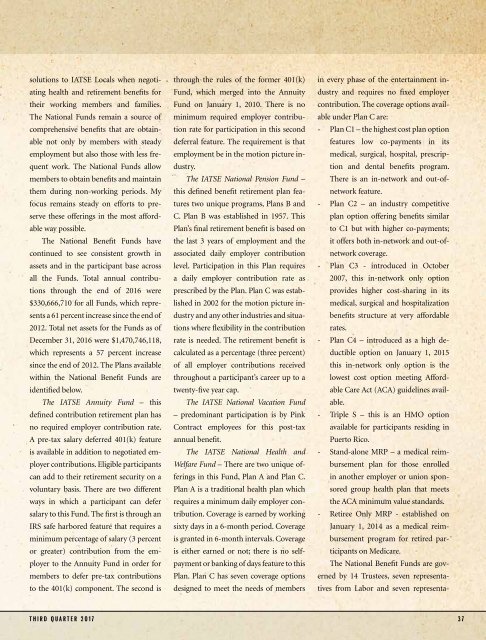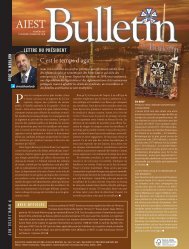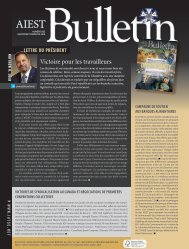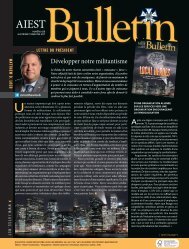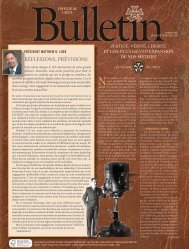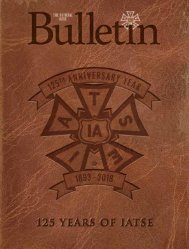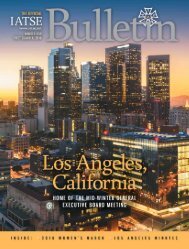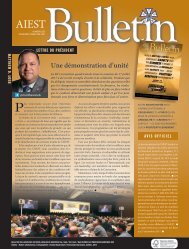IATSE_3rd2017_web
Create successful ePaper yourself
Turn your PDF publications into a flip-book with our unique Google optimized e-Paper software.
solutions to <strong>IATSE</strong> Locals when negotiating<br />
health and retirement benefits for<br />
their working members and families.<br />
The National Funds remain a source of<br />
comprehensive benefits that are obtainable<br />
not only by members with steady<br />
employment but also those with less frequent<br />
work. The National Funds allow<br />
members to obtain benefits and maintain<br />
them during non-working periods. My<br />
focus remains steady on efforts to preserve<br />
these offerings in the most affordable<br />
way possible.<br />
The National Benefit Funds have<br />
continued to see consistent growth in<br />
assets and in the participant base across<br />
all the Funds. Total annual contributions<br />
through the end of 2016 were<br />
$330,666,710 for all Funds, which represents<br />
a 61 percent increase since the end of<br />
2012. Total net assets for the Funds as of<br />
December 31, 2016 were $1,470,746,118,<br />
which represents a 57 percent increase<br />
since the end of 2012. The Plans available<br />
within the National Benefit Funds are<br />
identified below.<br />
The <strong>IATSE</strong> Annuity Fund – this<br />
defined contribution retirement plan has<br />
no required employer contribution rate.<br />
A pre-tax salary deferred 401(k) feature<br />
is available in addition to negotiated employer<br />
contributions. Eligible participants<br />
can add to their retirement security on a<br />
voluntary basis. There are two different<br />
ways in which a participant can defer<br />
salary to this Fund. The first is through an<br />
IRS safe harbored feature that requires a<br />
minimum percentage of salary (3 percent<br />
or greater) contribution from the employer<br />
to the Annuity Fund in order for<br />
members to defer pre-tax contributions<br />
to the 401(k) component. The second is<br />
through the rules of the former 401(k)<br />
Fund, which merged into the Annuity<br />
Fund on January 1, 2010. There is no<br />
minimum required employer contribution<br />
rate for participation in this second<br />
deferral feature. The requirement is that<br />
employment be in the motion picture industry.<br />
The <strong>IATSE</strong> National Pension Fund –<br />
this defined benefit retirement plan features<br />
two unique programs, Plans B and<br />
C. Plan B was established in 1957. This<br />
Plan’s final retirement benefit is based on<br />
the last 3 years of employment and the<br />
associated daily employer contribution<br />
level. Participation in this Plan requires<br />
a daily employer contribution rate as<br />
prescribed by the Plan. Plan C was established<br />
in 2002 for the motion picture industry<br />
and any other industries and situations<br />
where flexibility in the contribution<br />
rate is needed. The retirement benefit is<br />
calculated as a percentage (three percent)<br />
of all employer contributions received<br />
throughout a participant’s career up to a<br />
twenty-five year cap.<br />
The <strong>IATSE</strong> National Vacation Fund<br />
– predominant participation is by Pink<br />
Contract employees for this post-tax<br />
annual benefit.<br />
The <strong>IATSE</strong> National Health and<br />
Welfare Fund – There are two unique offerings<br />
in this Fund, Plan A and Plan C.<br />
Plan A is a traditional health plan which<br />
requires a minimum daily employer contribution.<br />
Coverage is earned by working<br />
sixty days in a 6-month period. Coverage<br />
is granted in 6-month intervals. Coverage<br />
is either earned or not; there is no selfpayment<br />
or banking of days feature to this<br />
Plan. Plan C has seven coverage options<br />
designed to meet the needs of members<br />
in every phase of the entertainment industry<br />
and requires no fixed employer<br />
contribution. The coverage options available<br />
under Plan C are:<br />
- Plan C1 – the highest cost plan option<br />
features low co-payments in its<br />
medical, surgical, hospital, prescription<br />
and dental benefits program.<br />
There is an in-network and out-ofnetwork<br />
feature.<br />
- Plan C2 – an industry competitive<br />
plan option offering benefits similar<br />
to C1 but with higher co-payments;<br />
it offers both in-network and out-ofnetwork<br />
coverage.<br />
- Plan C3 - introduced in October<br />
2007, this in-network only option<br />
provides higher cost-sharing in its<br />
medical, surgical and hospitalization<br />
benefits structure at very affordable<br />
rates.<br />
- Plan C4 – introduced as a high deductible<br />
option on January 1, 2015<br />
this in-network only option is the<br />
lowest cost option meeting Affordable<br />
Care Act (ACA) guidelines available.<br />
- Triple S – this is an HMO option<br />
available for participants residing in<br />
Puerto Rico.<br />
- Stand-alone MRP – a medical reimbursement<br />
plan for those enrolled<br />
in another employer or union sponsored<br />
group health plan that meets<br />
the ACA minimum value standards.<br />
- Retiree Only MRP - established on<br />
January 1, 2014 as a medical reimbursement<br />
program for retired participants<br />
on Medicare.<br />
The National Benefit Funds are governed<br />
by 14 Trustees, seven representatives<br />
from Labor and seven representa-<br />
THIRD QUARTER 2017 37


